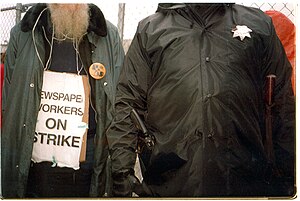San Francisco newspaper strike of 1994
| San Francisco newspaper strike of 1994 | |||
|---|---|---|---|
 | |||
| Date | November 1--12, 1994 | ||
| Location | |||
| Parties | |||
| |||
The San Francisco newspaper strike of 1994 was a labor dispute called by the
Leadup to the strike
San Francisco's two major daily newspapers were longtime rivals that had been working under a joint operating agreement since 1965.[1] Employees had been working without a contract for the past year.
Wages were one major issue leading to the strike: while the unions demanded a 3.5 percent annual raise, management offered only a 2.46 percent annual raise over four years. Another point of contention was management's plan to cut the jobs of more than 150 teamster drivers over several years.[2]
The strike
The strike turned violent. Bricks were thrown through paper carriers' windshields as they drove from the newspaper distribution center, and one non-union driver was hit on the head with a lead pipe, suffering a fractured skull. One teamster driver was killed by electricity when scaling a power pole.[3]
Two online newspapers
At the beginning of the strike, The Examiner's Head of Development Chris Gulker re-launched his pilot web project called the Electric Examiner[4] as The Gate,[5] thus creating the official online version of San Francisco's two big newspapers. This news service remained "heavily dependent on wire-service stories"[6] for lack of contributing journalists and editors.
The striking journalists set up their own online newspaper, the San Francisco Free Press,[7] and competed with The Gate as "the soul of the Examiner and the Chronicle."[8] Led by the Examiner's Associate Editor Bruce Koon and former SF Weekly editor Marcelo Rodriguez,[9] they received assistance from Cynsa Bonorris, who coded the html, and Dave Winer, who pitched in helping automate the production process.[10] The team operated from a makeshift newsroom using their own hardware and a local ISP for rented server space.[11]
The Free Press scored a scoop during its first week, reporting that Senator Dianne Feinstein had been wrongly accused of hiring an undocumented worker in the early 1980s.[12]
During the strike both online newspapers were claiming a total of more than 100,000 readers a day, which was a fraction of the actual newspapers' estimated circulation of 600,000, but far beyond the 10,000 or so people in the Bay Area who had access to them.[12]
Negotiations and settlement
On November 12, 1994, after eight straight days of negotiations mediated by San Francisco Mayor Frank Jordan, the newspaper strike came to an end as management and a conference of eight unions announced a tentative agreement.[13]




